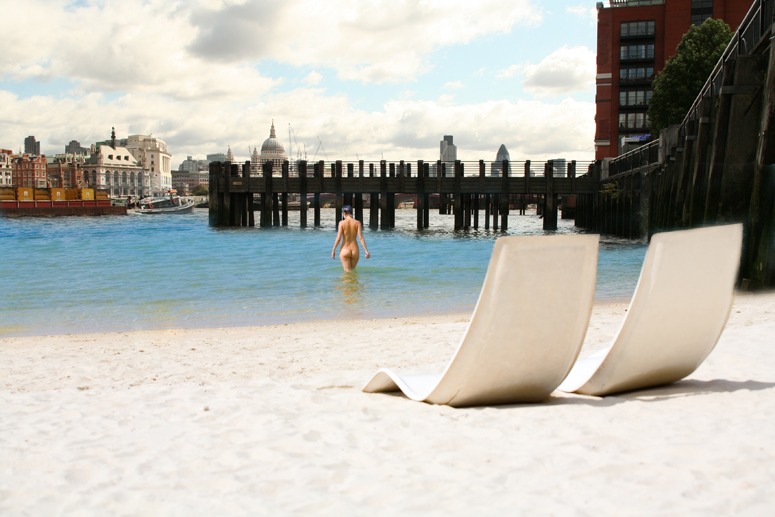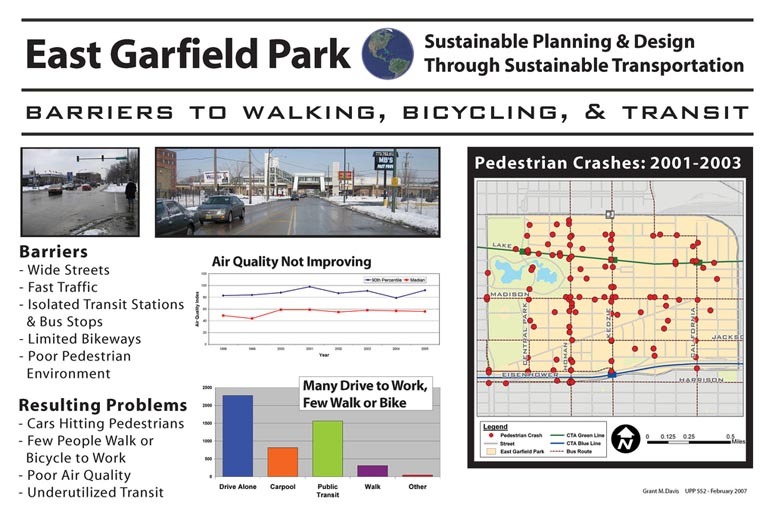I guess she is going to be OK. If wild swimming takes place in the River Thames upstream, as it does, then the biological hazard should be less in the tidal Thames – because the water is salty and salt is a disinfectant. ‘The discovery of a colony of short-snouted seahorses (Hippocampus hippocampus) living in the Thames means that the London river is becoming cleaner, conservationists said…Scientists from the Zoological Society of London (ZSL) have discovered five seahorses during routine conservation surveys in the Thames estuary in the past 18 months, evidence which they say indicates that a breeding population exists.’ The River Thames Website explains the position as follows: ‘The water quality is very good and in fact the tidal Thames is now acknowledged to be one of the cleanest metropolitan rivers in the world’. Thames water is pleasantly warmer than sea water with about 75% of its ‘thermal pollution’ coming from power stations. One man’s thermal pollution is one girl’s heated water. There is also a good supply of mud for her fair skin and she will be able to save money on spa treatments and make a sustainable contribution to combating climate change. One thing which does worry me though is whether she has a sufficient layer of Factor 30 sun screen. If the brave girl is poisoned there will be a public outcry and the River Thames Cleanup, underway since the 1960s, wll then be driven by a popular outcry. I regret that it takes a tragedy to effect reform but as Tertullian remarked, ‘the blood of the martyrs is the seed of the Church’.
Category Archives: Sustainable design
Peak Oil Group Taskforce and the need to plan for greener transport – urban design with veloways and cycletubes?

Planning cycle routes is the healthiest, fastest, cheapest, greenest and most ecological approach to greener rural and urban transport in the coming age of Peak Oil
Urban design, GDP/capita and the theory of good city form
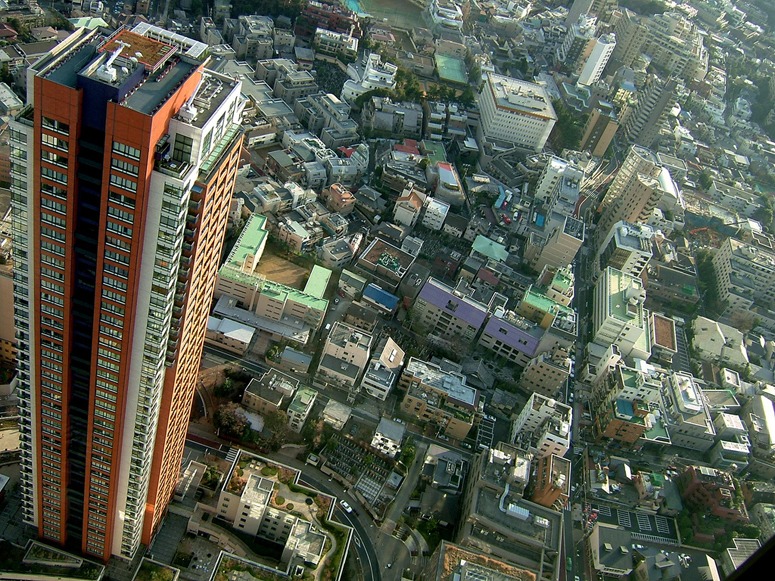
This is the world's richest city. Do you want to live here? Where is it? Does it look really American?
Kevin Lynch wrote a book on the Theory of Good City Form (MIT Press, 1981). His criteria were vitality, sense, fit, access, control, efficiency and justice. None of the criteria are readily measurable and Kevin Lynch did not identify which cities best satisfy them. One imagines he would have given Boston a good position in the ranking of North American cities. Lynch does not mention sustainability – and doesn’t everyone want more money? And so shouldn’t GDP/head be on Lynch’s list? After all, its more measureable and one can even find a ranking of cities by per capita GDP on Wikipedia. It goes like this: Tokyo $1479/head, New York City $1406/head, Los Angeles $792/head, Chicago $574/head, London $565/head, Paris $564/head, Osaka $417/head, Mexico City $390/head, Philadelphia $388/head, São Paulo $388/head. I am surprised that the city at the top of the list is four times as productive as the city in tenth position. Boston is not in the top ten and nor are Edinburgh, Rome, Kyoto, Isfahan, Munich, Hangzhou or many of the other places admired by urban designers. Are we barking up the wrong trees? Or are there no connections between the quality of the urban landscape, the desirablilty of a city as a place to live and the economic productivity of the settlement? And what has size got to do with it? Peter Hall argues that the best size for a city is about 1 million people. The top ten list of cities by GDP suggests to me that bigger cities tend to be more productive. Here are the top ten cities by size: Tokyo, Seoul, Mexico City, Delhi, Mumbai, New York City, São Paulo, Manila, Los Angeles, Shanghai.
(Above photograph of Tokyo, courtesy riverseal)
Urban landscape design in Dharavi, a Mumbai slum
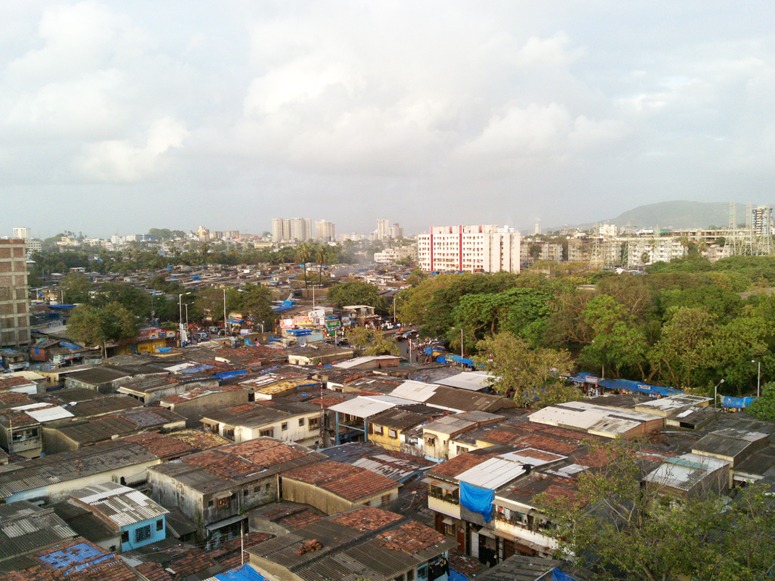 Kevin McLeod has shifted his gaze from Castleford to Dharavi. Properly critical of the sanitation, he finds much to praise in its community spirit and, like Slumdog Millionaire, criticizes the Bombay policy of trying to move the residents into Corbusian blocks of flats. He finds Dharavi as a happy place where everyone lives together and works together. Most people work within Dharavi so little money wasted on commuting. Kids don’t wear hoods and mug old ladies, because they have work to do. The crime rate is extremely low becuase everyone knows what everyone is doing. Dharavi is in fact like a medieval European town. We got rid of them in the mistaken belief that ‘foul air’ (rather than foul water) was causing infectious diseases. Now that this mistake has been cleared up, we should rid the world of highway regulations and let people build dwellings on narrow lanes if that is what they want to do. Dharavi is sustainable and will survive unless the police clear it.
Kevin McLeod has shifted his gaze from Castleford to Dharavi. Properly critical of the sanitation, he finds much to praise in its community spirit and, like Slumdog Millionaire, criticizes the Bombay policy of trying to move the residents into Corbusian blocks of flats. He finds Dharavi as a happy place where everyone lives together and works together. Most people work within Dharavi so little money wasted on commuting. Kids don’t wear hoods and mug old ladies, because they have work to do. The crime rate is extremely low becuase everyone knows what everyone is doing. Dharavi is in fact like a medieval European town. We got rid of them in the mistaken belief that ‘foul air’ (rather than foul water) was causing infectious diseases. Now that this mistake has been cleared up, we should rid the world of highway regulations and let people build dwellings on narrow lanes if that is what they want to do. Dharavi is sustainable and will survive unless the police clear it.
I remember spending a morning in a Roman town on the south coast of Turkey. There were no residents and no visitors. It was empty. One day, Dubai will be like this. The owners should have learned something from the Indians about sustainable urban design, instead of paying them peanuts to build Chicagos on the the Gulf.
(Image courtesy markhillary)
Note: Dharavi rhymes with laramie
Learn from wombats: earth sheltered homes have a lower environmental impact
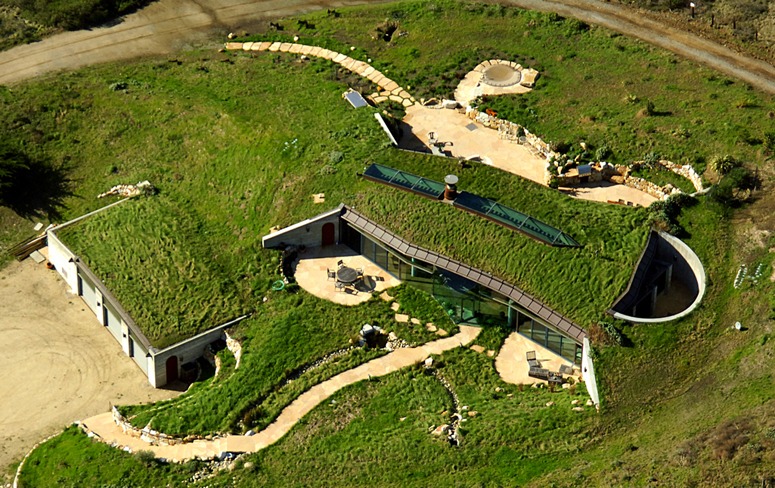
The sunken garden looks nice but they could have done more with the external space for this earth-sheltered dwelling house in California
When reducing the total impact of humans on the environment becomes a necessity, we may have to learn more from the lifestyles of wombats, teletubbies and hobbits. If so, I hope our species will also become cuter, cuddlier, and friendlier. JRR Tolkien may prove correct in his view that diminutive sausage-eaters will save the world from the black forces of evil.
PS But is that a triple garage?
(image courtesy Christopher Line)
Can sustainable urban design and landscape architecture help combat global warming?
Watching Al Gore’s Inconvenient Truth at one sitting led me to the following conclusions:
- The film is excellent and has much to teach college lecturers, both about the analysis of complex issues and about the the use of words & images in presenting an argument.
- Gore’s argument is weakened by his homepage link to a Buy Now button on climatecrisis.net – regardless of how he shares the profits. It makes him seem like a greedy evangelist on TV.
- Gore’s list (below) of Thing’s You Can Do Now, is ultra-trivial and may have set back the cause by encouraging politicians to believe that little change is necessary. The film mentions population growth but it is not on the list, doubtless for ‘political’ reasons.
- The best commentary on the issues comes from Justice Burton. He said the film is ‘broadly accurate’ but listed nine inaccuracies
- A landscape approach to urban design can do more to combat climate change than Al Gore can imagine. We can and should:
- use all roofspace: for vegetation, gardens, power generation or the daylighting of interior space
- plan cities for extensive use of human-powered and solar-powered transport (above image courtesy TouringCyclist) – but see my recent post on White Commuting
- compost as much as possible within the boundaries of each and every property
- infiltrate as much water as possible within the boundaries of each and every property
- make all buildings energy efficient, by orientation, vegetation, insulation, durability, daylighting, avoidance of lifts and escalators etc
- design new homes so they can become home offices, when eCommuting becomes the norm, with a smooth transition from indoor to outdoor spaces with differential climatic and temperature characteristics
For landscape architects and urban designers thinking about new jobs and professional opportunities in sustainable urban design, the above are very convenient truths.
Another ‘inconvenient truth’ ignored by Gore, is that the environmental impact of bottled water has been calculated, by SGWA, to be 1000 times greater than that of tap water. So ban it, as a small town in Australia has done: Bundanoon, in New South Wales. Perhaps the American language needs a new word: an ‘ingored truth’

